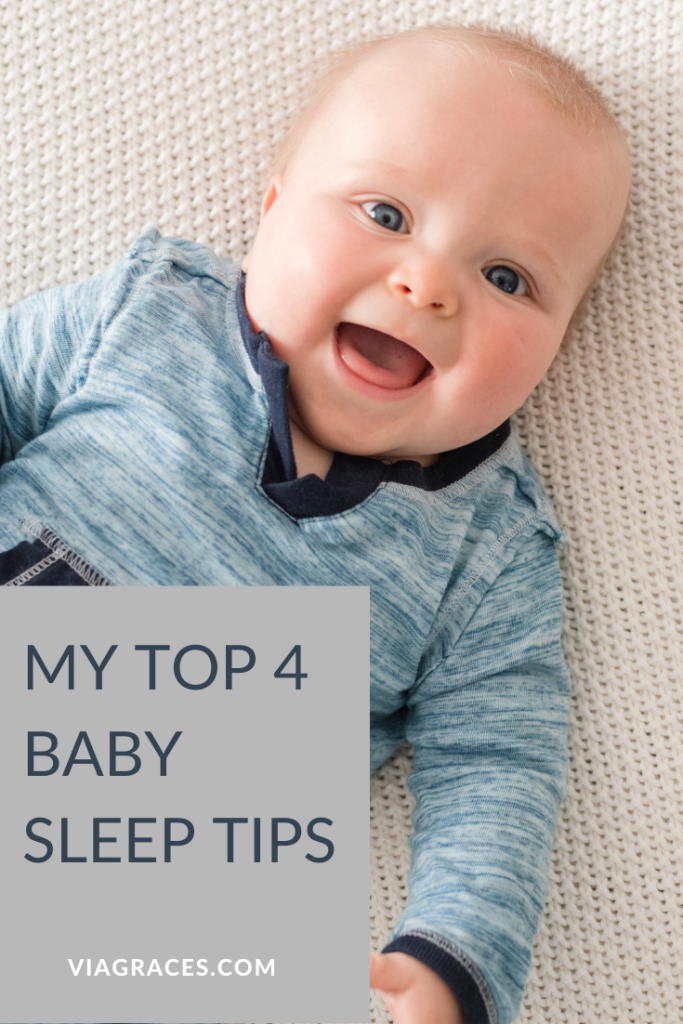Whether your baby was a pretty good newborn sleeper or not, her physical sleep will change come four months old (hello, four month regression!).
Because babies’ sleep goes through a big adjustment, our approach to their sleep should adjust, too.

So in this blog post, I will walk you through my top four tips for babies ages 4-17 months, including:
- Follow age-appropriate awake windows
- Lay your baby down awake (not drowsy!)
- Keep a space between feedings and sleep
- Establish consistent nap and bedtime routines
(Much of this still applies in those early toddler years, as do these tips on toddler/older child sleep.)
Follow Age-Appropriate Awake Windows
Just as awake windows are a top priority in newborn world, they are still incredibly important for our babies. In order to give babies the best chance of falling asleep and having good naps and overnight sleep, it’s important that they build up the right amount of sleep pressure, and this is done by following awake windows.
An awake window is the amount of time your child is awake between sleeps, and it’s in that awake window that your baby will both eat and play.
While tired cues can be helpful to determining your child’s “sweet spot” of an awake window, they can also be misleading, as tired cues often come too early or too late. So when you get your baby up for the day, or up from a nap, set your timer and aim to be laying your child down in her crib, ready to move toward sleep, when that awake window is over. Here are some general guidelines for your baby’s awake window by age:
4 months- 1.5-2 hours
6 months- 2-2.5 hours
9 months- 3 hours
12 months- 3.5-4 hours
Another tip: babies generally need a slightly shorter awake window in the morning and a bit longer of an awake window before bedtime.
Go snag my FREE Ultimate Guide to Sleep Schedules to see how these awake windows fit into a schedule for your baby!
Lay Your Baby Down Awake, Not Drowsy
A helpful tip for getting newborns to start learning to fall asleep in their crib or bassinet is laying them down “drowsy but awake.” Have you heard that phrase before? What you probably haven’t heard as often, however, is the importance of then switching to “awake, not drowsy” once we leave newborn world.
Because babies now have four adult-like sleep cycles rather than two underdeveloped cycles, the first stage of their sleep is essentially drowsy.
You can read more about your baby’s sleep cycles here!
So if you lay your baby down drowsy, two scenarios are likely to happen. One, she will pop awake the moment you lay her down and she’ll now be extra upset and frustrated, not to mention awake, and you’ll have to do the work of getting her drowsy again.
Or two, your baby will fall asleep, however when she experiences a natural wake-up later in the night, she’ll wake up looking for the same help to get back to sleep because she doesn’t know how to do so herself.
In order to be able to lay our babies down awake, not drowsy, we need to drop any sleep props we’ve been relying on to get her to sleep/back to sleep. And this is exactly what sleep training is – teaching your child those independent sleep skills to fall and stay asleep.
Keep Feeds Separate from Sleep
I hesitate to use the word “schedule” here, because I’m not talking an every 3 hour feeding schedule – I’m talking about when in the awake window you feed your baby.
A “trap” I notice a lot of parents fall into when trying to follow the classic Eat-Play-Sleep routine (in attempts to avoid a feed-to-sleep association) is feeding their baby the moment she wakes up.

However, if the moment our babies wake up we are breast or bottle feeding, there is very likely still a feed-to-sleep association! For that reason, I tell the families I work with to wait at least 10 minutes after a baby wakes from her nap or in the morning before offering a feeding. You can even wait longer, if necessary, based on when the last feeding was offered and how long the nap was.
Similarly, we want to make sure any feedings are done at least 20 minutes before moving toward the next nap or night time, to make sure our babies are not getting drowsy in that feed or relying on it to put them to sleep.
Establish Consistent Nap and Bedtime Routines
And last, but most definitely not least, is having a solid nap and bedtime routine that helps alert your baby’s mind and body that sleep is coming. We want this to be a routine that anyone can replicate, no matter who is putting your baby to sleep.
Conclusion
Some of you may be reading this and it was just the adjustment you needed to hear in order to make some changes to help solidify your baby’s sleep. Others may be reading this completely overwhelmed, wondering how to actually do all of this. If that’s you, you don’t have to do this alone! I would love to come alongside you and help you navigate these changes. Set up a (free!) call with me to chat more details!
Looking to learn more? Baby Sleep from A to Z is everything I wish I had known about newborn and baby sleep when my oldest was born. The video and workbook will help you can feel confident in adjusting routines, understanding your little one’s sleep needs, and feeling confident in supporting those needs as your baby keeps growing!
With Grace,
Lauren
Did you find this helpful? Or know someone who would? I’d love for you to follow me on Pinterest and pin it for later!
